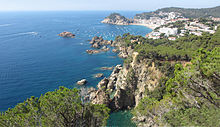Wildlife of Spain
Peninsular Spain largely consists of a highland plateau, surrounded and dissected by mountain ranges and rivers.
[1] Much of the country experiences a Mediterranean climate with warm or hot, dry summers and the rainfall falling in winter.
In connection with Natura 2000, a European Union initiative, 27% of the country is included in national parks, wildlife reserves and other protected areas.
[3] Including the mainland and the island groups, Spain has eight to nine thousand species of vascular plants, more than any other country in Europe.
Much of this terrain is now covered with dense shrubland known as maquis, with scattered low trees, bushes and herbaceous plants.
In the river valleys, only remnants remain of the natural deciduous woodland of willow, poplar, alder, ash and elm.
The coastal part of northwestern Spain has plentiful deciduous forests dominated by common oak, lime, chestnut, elm, ash, maple and hazel, and where the tree cover is lacking, heather and gorse.
[7] There are certain plant species that occur in the entire Spanish territory, including the archipelagoes, such as the Dryopteris filix-mas, Arum italicum (of the same genus as adder's meat), borage, lamb's quarters, Bermuda grass, Mercurialis annua and Eruca vesicaria.
[12] The upland plateaus provide habitat for Dupont's lark, horned lark, European roller and black wheatear, and the remaining sclerophyllous woodland provides overwintering for thousands of common crane and breeding areas for white storks and black storks, as well as black-winged kite, short-toed snake eagle, cinereous vulture and griffon vulture.


Continental oceanic climate
Coastal oceanic climate
Subtropical climate
Mountain climate
Semi-arid steppe climate
Continental Mediterranean climate
Coastal Mediterranean climate





